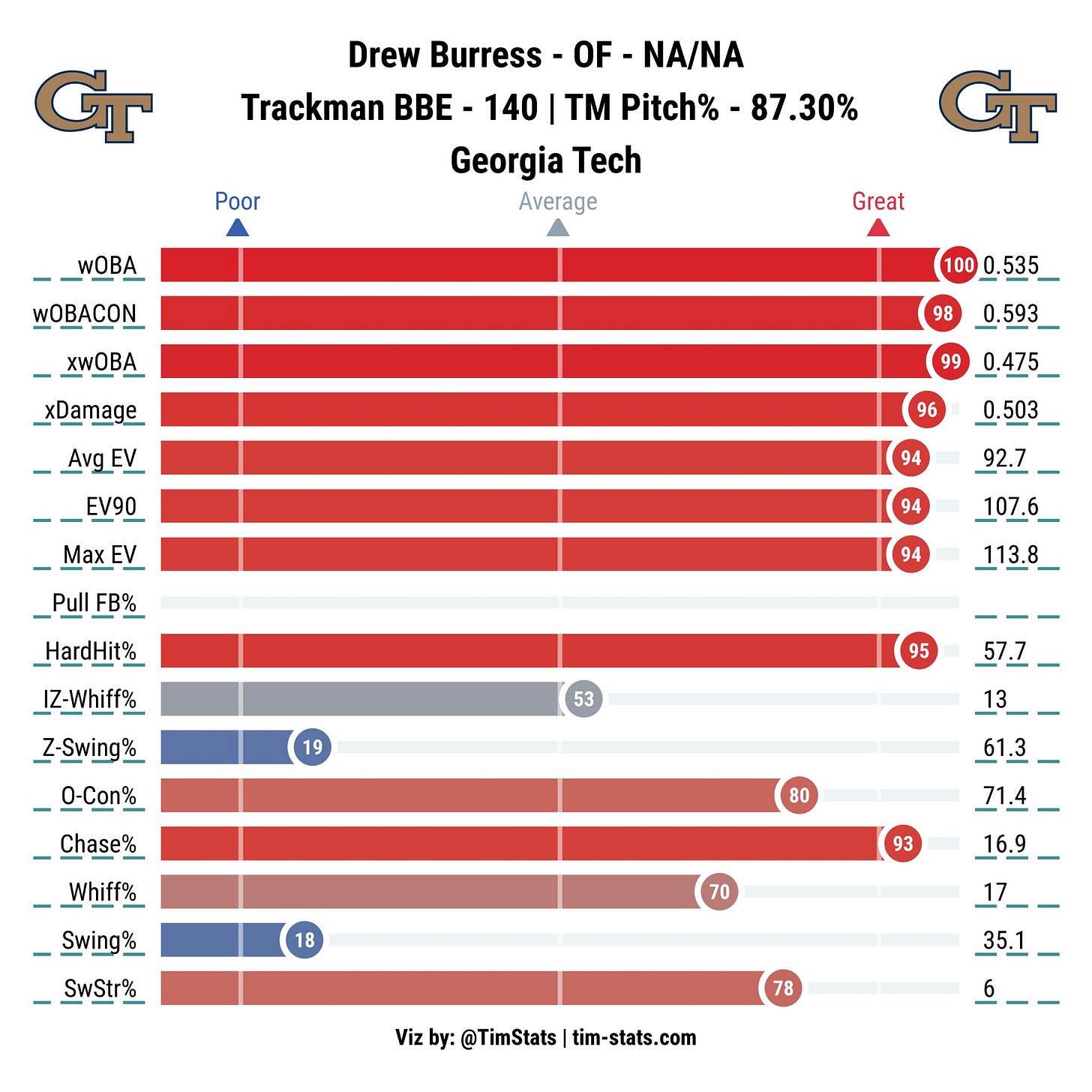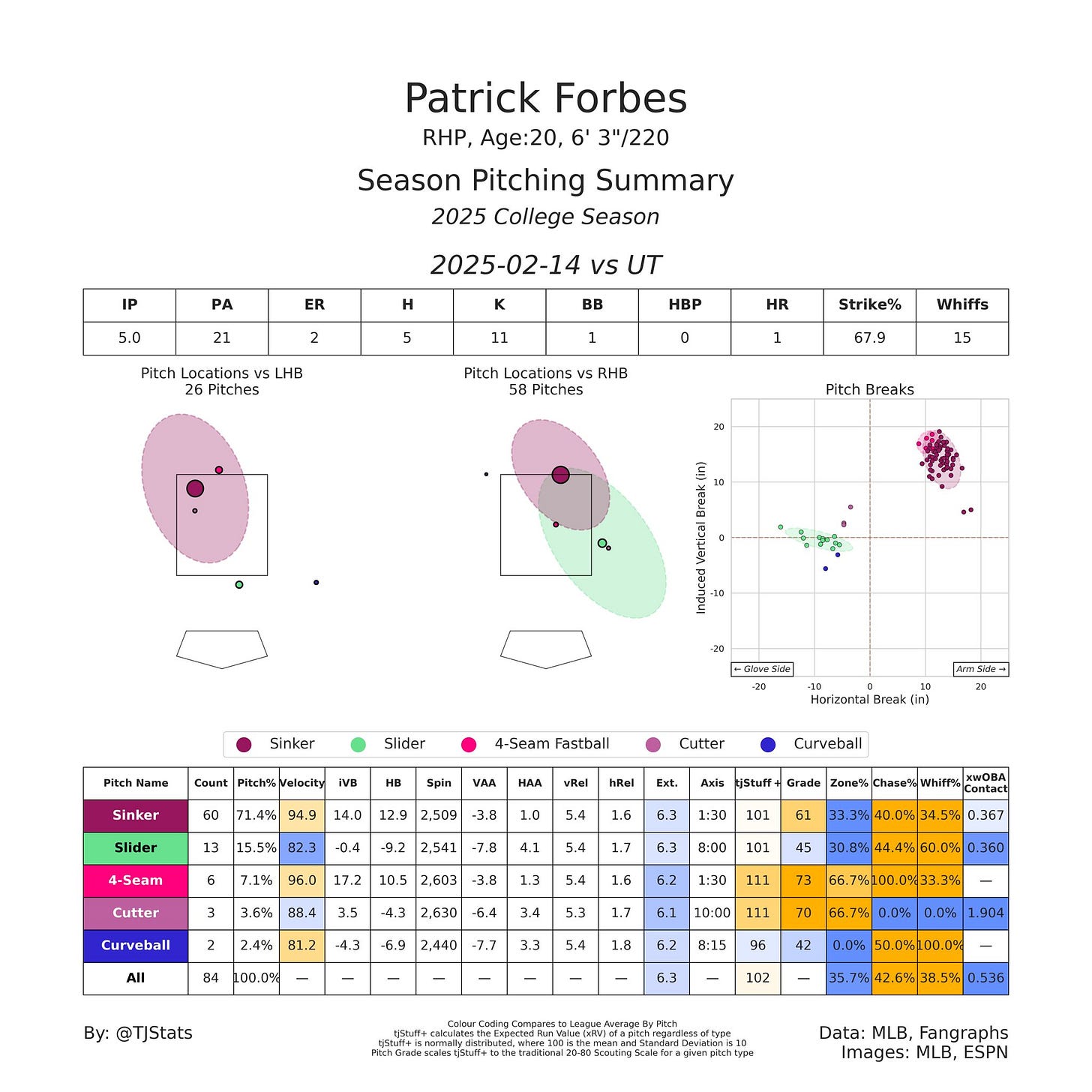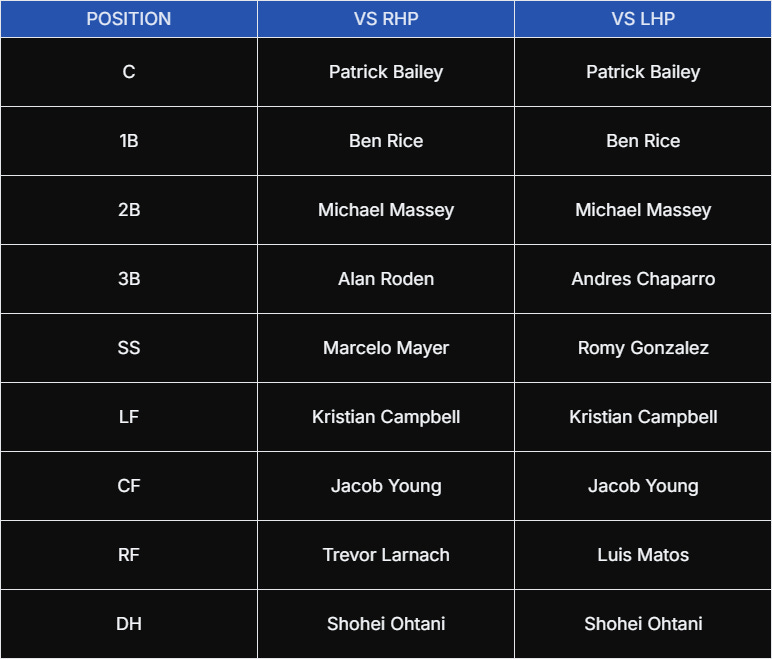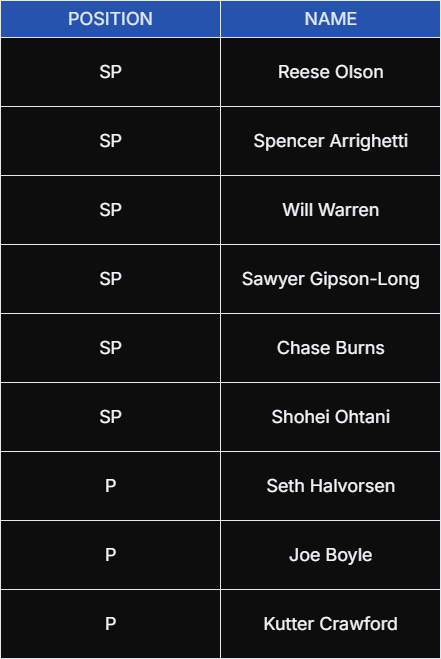Starting Anew
Building an organization in my image
Introduction
This was the 12th iteration of the “franchise draft,” where 30 teams get to build their own organization like one would in a dynasty fantasy baseball league. The key differences are that players are evaluated based on real life performance, so defense is a critical factor, and players are bound to your team forever, so no contract considerations. No trading stars for Kyle Harrison and Jordan Hicks in this house!
I ended up with the 6th pick, and the priority was position players early, given my general strength is pitching evaluation and the innate volatility of arms. In the first three rounds, I hoped to come away with a SS, CF, and either a top prospect or C. At pick 6, getting a SS or capable CF was virtually guaranteed; only the inexplicable fall of Soto or Ohtani would prevent that. After that, it's heavy platooning for the offense, getting reliable arms for the staff, and a keen eye to prospects that I feel are falling too far. Given how long ago this was done (early Feb), I can add some additional commentary on how the picks look as of June. When looking through this, it's funny how quickly things can change in a few months.
The “X.XX” format in the picks’ information line indicates first the round, then the overall pick for each player. For instance, round 1 pick 6 is:
1.06 - Shohei Ohtani - 30 - Los Angeles Dodgers - DH/SP
I had anticipated a tough choice between Elly de la Cruz and Jackson Merrill here to fill a spot up the middle, but Ohtani fell to me after an aggressive selection of Vladimir Guerrero Jr. the pick prior. Since payroll flexibility is irrelevant with contracts ignored, Ohtani is an easy selection with elite offensive skills and flashes of Cy Young level stuff. I’m almost certain the Dodgers will tinker with Ohtani’s arsenal in his first year back on the mound; as in the top 50 blurb about Shohei, I see more sinkers on the horizon to reduce the load on his 4-seam. De la Cruz ended up going a few picks later, while Merrill dropped all the way to 17th. De la Cruz was my preferred option with quality major-league shortstops in short (heh) supply compared to center fielders, but Merrill is about as safe as someone his age can get.
2.55 - Patrick Bailey - 25 - San Francisco Giants - C
With few elite catchers around, I turned to my top preference in Patrick Bailey in round 2. His defensive acumen is well-known, with clear first placements in both DRS and FRV across 2024, but the bat was given too harsh a grading at an 81 wRC+. His xWOBAs came in around .320 when considering pull rate (or not), his 90th percentile and average EVs were at or above the 70th percentile, and his plate discipline was passable. Despite such a noodle bat, he was 12th in prorated fWAR amongst all players at 6.25 fWAR/650 PA. He has struggled more than ever on that end so far this season, but if he can get back to being simply below-average hit, he will be a real stalwart player.
3.66 - Kristian Campbell - 22 - Boston Red Sox - 2B/OF
This was a difficult decision with multiple capable outfield options. There was the stable choice of Brenton Doyle, the more aggressive choice of Jasson Dominguez, and the ultra aggressive choice of Evan Carter, but I elected to get flexible with the high-upside Campbell. He’s struggled since his great April after pitchers honed in on his weaknesses on the outer third and with soft stuff, but he surely will adjust back in kind to return to being a stable all-around hitter. There are bits of Mookie Betts here, especially if he can tap into the pull side.
4.115 - Marcelo Mayer - 22 - Boston Red Sox - SS
I certainly did not plan on picking Mayer, but the unexpected availability of Ohtani set me back on handling short. Mayer and Lawlar were the two prime candidates, and I liked Mayer slightly more with the better defensive track record. My aggregated prospect rankings had them tied, so I couldn’t really go wrong either way. I also considered Pete Crow-Armstrong here to fill my CF vacancy, but I had something in mind there for later. How brilliant that would have been.
5.126 - Chase Burns - 22 - Cincinnati Reds - SP
The direction of the draft became clear at this point, with far more pitchers selected per round than I had seen in the prior editions. That made my choice difficult: do I go for a hitter, which were better stocked than usual at this point, or a pitcher, which was far worse stocked. I opted for the latter, and I begrudgingly skipped over the quickly falling Bryan “Woocifer” Woo to select Chase Burns. He had better swing-and-miss numbers in college than Paul Skenes with an incredible 4-seam/slider/curve combination that is simply electric. The latter two offerings ran whiff rates above 60% in his last year at Wake Forest, and he struggles to find room for a 90 mph changeup and 88 mph cutter that most pitchers would kill to possess. He is arguably the best-performing SP prospect so far in 2025 with unexpectedly sharp command, and he’s already good enough to pitch in Cincinnati every five days. Whenever he does appear, it’ll be fireworks.
6.175 - Reese Olson - 25 - Detroit Tigers - SP
With starters continuing to fly off the shelves, I take my first full-time major-league starter in Reese Olson. I covered him in SPs to Watch, but his sinker/slider/changeup mix is high caliber. It’s hard to find someone who can frequently keep the ball on the ground (93rd percentile) while eliciting swing-and-miss (72nd percentile), but Olson manages to do both. Success stories like Skubal and Flaherty gave me faith that the Tigers will tweak the mix in the proper manner to get the most out of him, and their decrease in his weak 4-seam’s usage by 10% in 2025 supports that belief so far.
7.186 - Spencer Arrighetti - 25 - Houston Astros - SP
After fierce deliberation between the above, Bobby Miller, David Festa, Kutter Crawford, and Sean Burke, I chose the Astro. He consistently posts 7 feet of extension to effectively add 1.5 ticks to everything he throws, and his low release gives him elite approach angles on his fastball and cutter. His curve has huge sweep at a respectable 78 mph to get lots of whiffs. His sweeper and changeup carry low usage, and his latter is the pitch to watch; I think it can be tweaked for more run to differentiate it more from the heater. Currently, it’s just 3 inches, which makes it only a mediocre offering for its 8% usage. He’s struggled to keep things in line for his first 9 ⅓ innings before getting injured, but he remains nasty when he gets things right.
8.235 - Trevor Larnach - 28 - Minnesota Twins - OF
I needed a quality bat in the middle of the lineup, and after Matt Wallner’s selection, I pulled the trigger on Trevor Larnach. He’s a platoon hitter, but that’s part of my overarching strategy with the later selections. Larnach posted a 124 wRC+ last season against right handers in 2024 and demonstrated a more consistent approach with a 12% drop in K rate to an average 22%. The cost wasn’t felt in his swing decisions, with his SEAGER remaining top tier, or his exit velocities, which actually went up 2 mph. He was more prone to a rollover, but his VBA remained at a great 38°, which suggests lots of flyballs ahead. I see a middle of the order hitter against RHP for the foreseeable future in the profile at a 130-140 wRC+, which is more than good enough to justify his questionable defense in left or his nonexistent baserunning threat.
9.246 - Josue de Paula - 19 - Los Angeles Dodgers - OF
I was very surprised that de Paula stuck around this long, but I was certainly pleased about it. He was the consensus 27th-best prospect based on my aggregation and is in an organization that can coax value out of hitters better than almost any other. He walked once per game and more often than he struck out at High-A Great Lakes, and projects as a real power threat with his 6’3” frame and having already nearly matched his 2024 home run total in half the amount of games in 2025. He is quick enough to be a solid corner outfielder and an average baserunner, which is far more than most people his size could hope for. I also considered teammate Zyhir Hope here.
10.295 - Jacob Young - 25 - Washington Nationals - OF
The Floridian finished tied for 1st in OF defensive value last season according to FRV, and tied for 2nd in FRV behind franchise backstop Patrick Bailey. A coincidence, I’m sure. He is a dynamic baserunner as well, finishing 2024 with 5.5 BsR/650 PA despite only average on base skills. He’s not ever going to be an elite hitter, but a .650 OPS is more than enough to be a defensive specialist batting 9th on the daily.
11.306 - Drew Burress - 20 - Georgia Tech Yellow Jackets - OF
Burress looks primed to be a top-3 pick in 2026 when first eligible. He had a monster freshman year that was supported by advanced metrics in full, although the quality of opposition could be called into question as an ACC representative. Nonetheless, he had the highest wRC+ of any ACC bat in 2024, ahead of first round draftees Nick Kurtz, James Tibbs, and Cam Smith, all his senior, and followed it up with a great sophomore year as well. He even had a four-homer game in his 8th ever collegiate game. That shows initiative.
Drew Burress had almost no weaknesses in his freshman ACC season. The low in-zone swing rate is justified by his walk per game. [TimStats]
12.355 - Kutter Crawford - 29 - Boston Red Sox - SP
I wrote an entire article about Kutter in my “SPs to Watch” series, but long story short, he’s the perfect fit for the Red Sox’s organizational crusade against 4-seamers. His kutter/sweeper/splitter combination is effective, and the triumvirate’s success has concealed the scale of the atrocious results of the 4-seam. I believe even a slight decrease in heater usage would do wonders for his overall results, and once he finally returns to injury, we might be able to put that theory to the test.
13.366 - Will Warren - 25 - New York Yankees - SP
I was hoping to wait quite a bit longer for Warren, but after my timeline was filled with posts about his great arsenal, I had to jump the queue. Again, a subject of one of my articles, Warren has an elite sweeper that is surrounded by pitches that move a crazy amount, but aren’t particularly complimentary of one another. His ICR is an absurd 48%, and he walks over 10% of the batters he faces. He still manages a lot of groundballs with his great sinker/sweeper combo and can post lots of strikeouts, so the potential is there if he can tap into his changeup and curve a little further to expand the palette.
14.415 - Lazaro Montes - 20 - Seattle Mariners - OF
I didn’t plan on grabbing Montes, but he was the last prospect inside the consensus top-70 left, and he was well within the top 50. He has drawn comparisons to Yordan Alvarez - like de Paula - with a similarly large frame to tap into easy power and great swing decisions in the lower minors. There’s questions about where he will play in the field, but the bat has looked incredibly sound at every level he's encountered. If he can hit 30 HRs with a .370 OBP, he can be Kyle Schwarber in the field if he likes. It won’t matter.
15.426 - Michael Massey - 27 - Kansas City Royals - 2B
Massey fills second base so Kristian Campbell can man left, and he was one of my favorite players entering 2025. While he has struggled to get the ball off the bat at a productive launch angle two months in, I see a left-handed Isaac Paredes with his elite contact rate and preference for pulled flyballs. Despite a mediocre .310 Savant xWOBA in 2024, his pull-adjusted xWOBA was a great .353 without a platoon situation concealing a weakness to southpaws. His defense is only ok at second base, and he won’t be stealing any bases, but he can hit 30 HR in a full-time starter’s share of playing time once he gets his swing straightened out. At a position possibly weaker than any other, that skillset is worth its weight in gold.
16.475 - Joe Boyle - 25 - Tampa Bay Rays - SP
Joe is known for sitting 98, and after seeing him sit 99.8 mph across 2 innings in a Spring Training game, I knew he may not have lasted the next 10 picks to get back to me. His slider has good drop considering its 89 mph, and he threw a single changeup (sometimes classified as a splitter) in those 36 pitches with 0 vert and 16 inches of run at 93 mph. That fastball/slider/changeup mix is monstrous and with the Rays’ track record of fixing command, Boyle feels like a great buy. Think Misiorowski without the crazy fastball properties or extension. If not for Doyle, I would’ve picked Sawyer Gipson-Long here with his 7 feet of extension and polished mix..
17.486 - Ben Rice - 26 - New York Yankees - 1B
It’s all about the Benjamins. Ben Rice filled an important need late in the draft here - a strong-side platoon first baseman - and the upside was clear. He pulls flyballs with authority, showcases great discipline, and can even flex to behind the plate with his collegiate catching experience. So far this year, he’s demonstrated that in spades against both sides of the platoon, although I’m still worried about how long he can get away with such poor numbers against breakers. Against heaters, though, he’s the man.
18.535 - Sawyer Gipson-Long - 27 - Detroit Tigers - SP
Like Will Warren, I had to jump the queue after top pitching analysts endorsed his skillset. It gets worse, though, given it was Nick Pollack, perhaps the best public pitching analyst (certainly my most referenced, at least), and that he proclaimed him his sleeper pick of the year! Oh brother. Sawyer’s big calling card is his 7.5 feet of extension that is only matched by fellow freaks like Tyler Glasnow. His otherwise mediocre velocity plays up from that outlier release and enables his already unique pitches to reach their max potential. The slider, changeup, and sinker completely drop off the table, which when paired with elite carry on his 4-seam makes a nightmare mix to handle. He is only returning now, but he has demonstrated a retention of most of his unicorn skills throughout his many efficient minor league rehab starts.
19.546 - Alan Roden - 25 - Toronto Blue Jays - 3B
The battle for the starting job at third base was between three players: Payton Eeles, Shay Whitcomb, and Alan Roden. Whitcomb seemed a little too swing-happy and Eeles demonstrated a worse process outside of pitch selection with a similar style, so the Creighton graduate it is. Roden is a contact-heavy bat with the potential to hit 15 HRs while not making a fool of himself chasing out of the zone. He also has the flexibility to move left field, which could prove useful. He struggled to square up the ball on debut and was demoted quickly, but returned to crushing it in AAA in the meantime. I think he will do better during his second crack at things.
20.595 - Seth Halvorsen - 25 - Colorado Rockies - RP
I had been looking at Halvorsen for several rounds to this point, and despite many relievers being picked, he was not among them. The most exciting thing about his arsenal is his sinker: flat at 100 mph with 7 feet of extension. He could pitch in a little league park; that’ll play. He also has a 90 mph splitter with a good amount of run, a 4-seam that’s also triple digits, and an 89 mph slider with good depth. I think he could be the next elite reliever pickpocketed from the Rockies a la Nick Mears if they can’t unlock things at Coors. He’s absurd.
21.606 - Grant Taylor - 22 - Chicago White Sox - SP
Grant Taylor was a surprise to me when I saw him in Spring Training. I had never heard of him before, but he looked like an absolute menace. Absolute gas on every offering, well over 7 feet of extension, and a natural supinator to create nasty cut on his 4-seam and changeup (with great separation between the two as well). His curve could be classified as a 12/6 with 4 inches of sweep at 85 mph, and his cutter is 93 with low vert. I think he’s most comparable to Glasnow with the heat, extension, and lack of horizontal separation between the arsenal - less than 16 inches across 5 pitches. His one flaw is his erratic command, something Glasnow himself battled for several years. This could be a real prized pitcher as soon as 2026 with a touch more consistency.
During Spring Training, Taylor dominated with a crazy hard cut-fastball. [TJStats]
22.655 - Billy Carlson - 18 - Corona High School - SS
Now is the part of the draft where I start picking well-regarded players at the top of mock drafts. Billy Carlson was a top two high-school prospect at the time we were drafting, and shows (according to JustBaseball) elite instincts at shortstop with a frame that could grow into above-average hit and power. He’s also very selective in the zone.
23.666 - Aiva Arquette - 21 - Oregon State Beavers - SS
A top draft prospect in this upcoming draft, Arquette shows great physical tools while playing a competent shortstop. Some believe he will move to 3B at the pro level with his size (6’5”!!), and his great power would make him a natural fit there, but sources like Pipeline think he could stick at shortstop with his strong arm, “easy actions, [and] soft hands”. Arquette is another likely top-5 draft prospect, top-10 at worst.
24.715 - Justin Lebron - 20 - Alabama Crimson Tide - SS
Lebron wasn’t even born when LeBron debuted, confusing everybody. Evaluators believe he can stick at shortstop, while bringing the boom with the bat as if he was a third baseman. He seems like the 1.1 frontrunner in 2026 with some decline in Burress’ play this season.
25.726 - Andres Chaparro - 25 - Washington Nationals - 1B
I was interested in Chaparro in my Twins GM sim, and because I didn’t manage to get him there, I focused on trying to get him here. He demonstrated elite swing decisions (100th% in AAA, 85th% in MLB) and pulled flyball rates (98th% and 92nd%, respectively) in 2024, and can platoon vs LHP effectively at a minimum. His major hole is against breaking balls, and he lacks the strong EVs to be an above average major-league 1B at the moment.
26.775 - Luis Matos - 23 - San Francisco Giants - OF
I was hunting for a platoon outfielder, and Matos is a post-hype option there. He has top-of-the-line contact skills and solid pull and flyball rates. He lacks great power or swing decisions, and he’s struggled to perform in the majors. Regardless, he’s still young and is on the brink of everyday viability.
27.786 - Owen Murphy - 21 - Atlanta Braves - SP
ProspectLarceny, my north star, had him 5th in their MiLB pitcher rankings at the end of 2024. He has a fastball with incredible IVB, and a quality slider and curve as well (source). He was dominating High-A at age 20 before undergoing Tommy John surgery, so I got to get him cheap here.
28.835 - Connor Prielipp - 24 - Minnesota Twins - SP
I was looking for more pitchers with upside, and Prielipp with his elite K-BB% in limited time and quality three-pitch mix won out. Pipeline regards both his changeup and slider as + pitches, and JustBaseball calls the slightly-sweeping slide piece a 65. With quality velocity and solid command on all three offerings, he’s a safe bet to be an MLB starter for several years.
29.846 - Patrick Forbes - 20 - Louisville Cardinals - SP
I considered several collegiate SP here, but I elected to take Forbes. His calling card is an extremely flat 4-seam at 96 with so much run that it’s sometimes classified as a sinker, a sweepy slider at 82 and a cutter which could be classified as a slider with its moderate sweep, low vert shape at 88. It’s anyone’s guess what he would call those pitches, but there’s a clear foundation here.
Patrick Forbes at his best early in the year. [TJStats]
30.895 - Romy Gonzalez - 28 - Boston Red Sox - 1B
I didn’t know who to pick here so I grabbed a guy who can play all over against LHP. Given my platoon-heavy intent, I wanted someone to fill that role off the bench.
Final Roster
I’m content with how my roster turned out, even several months later. I did pretty well platooning, although I skipped my original LF platoon plan (Randal Grichuk) to continue my draft prospect binge. My one regret is probably picking Patrick Bailey; he probably would have lasted quite a while longer and there were plenty of minor league options close to the majors available long after. My original plan was to platoon Rice and Chaparro at 1B, but Rice’s great play allows him to be full-time on the roster while Chaparro splits time with Roden at third. Chaparro actually has way more time at the hot corner in the minors than at first, including over 70 games played there last year.
I really like the pitching staff I put together. I only picked one reliever (two if you count Boyle) because picking relievers isn’t very interesting, and most go undrafted. I certainly would have picked Sheehan (round 24) and Roupp (round 28) in a vacuum after falling way too far, but after grabbing them with the Twins, I thought it would be more interesting to go after different players. The one issue with the staff that I’m just noticing is the lack of LHP. Oh well.
The full draft is accessible here. Hope you enjoyed!
Sources
FanGraphs
BaseballSavant
BaseballReference
PitcherList
Alex Chamberlain's Pitch Leaderboard
Realestmuto Dashboard
TJStats
Specificially for Prospect Evaluation (I can't do it myself):
JustBaseball
BaseballProspectus
MLBPipeline
The Athletic (Keith Law)
MLBDraftInsider
ProspectLarceny
ScouttheStatline
Azad Earl
TimStats






